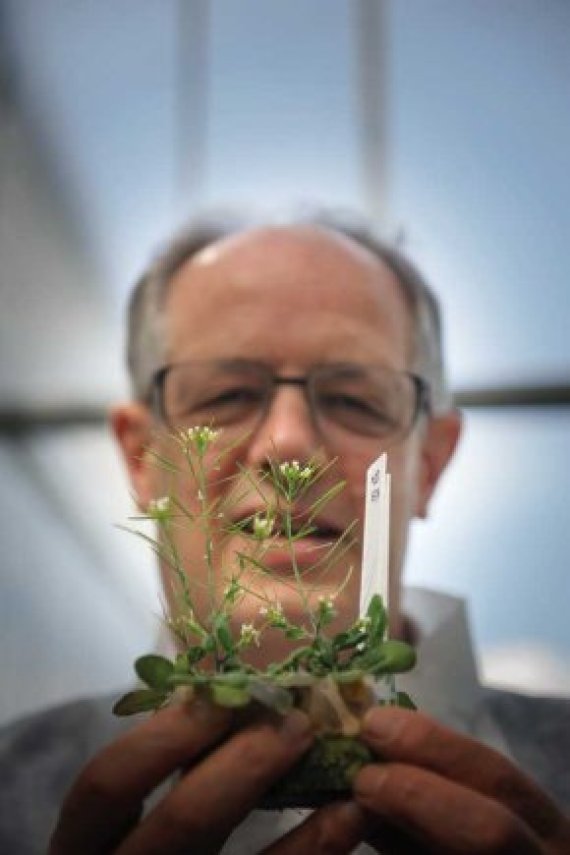He is the leading expert in the field of Arabidopsis research, say Wageningen colleagues who nominated him in 2004 as the greatest Wageninger of all times. A world authority who is among the most cited plant scientists. But that is heaping too much praise on him, in Koornneef’s own view. ‘I have problems with the very many kind words spoken. I am not really very different to my Wageningen colleagues.’ Koornneef has worked at Wageningen for over 35 years. As a young researcher he worked with his students to sequence the genome of Arabidopsis (Arabidopsis thaliana), which then became the model plant of choice for geneticists, molecular biologists and plant breeders around the world. For the last 20 years he has been personal professor of Genetics. He is still seen as the expert and a fount of knowledge for the rapidly expanding group of Arabidopsis researchers spread over several chair groups.
Mutants
In 1983, he published the first genetic map of Arabidopsis, with 76 genes. ‘It was very difficult to get the article published’, he recalls. ‘Arabidopsis was not "in".’ The complete genome of the Arabidopsis plant was published 13 years ago. Now there are an estimated 12,000 plant researchers studying this little plant. ‘We have about a hundred thousand different mutants, in each of which one gene has been switched off,’ says Koornneef. In other words, there is no other plant about which we know as much as we do about Arabidopsis. And there is no other European researcher who has a better overview that Koornneef. ‘The nice thing about Arabidopsis is that it has a small genome, just five chromosomes and only 25,000 genes. The genome includes almost all the basic processes you get in other plants as well, which makes it very functional. Through Arabidopsis we now know what role almost all plant hormones play in the plant’s development. Our knowledge about the development of the plant embryo, germination, flowering and root formation is based on research on Arabidopsis, too.’
Frustration
In 2004 Koornneef left for the renowned Max Planck Institute in Cologne, which offers more scope for fundamental research. ‘Not that I am fed up with Wageningen,’ he told Resource at the time. ‘I have been well enough appreciated here, but we didn’t manage to translate that academic appreciation into research funding. That is perhaps my only frustration.’ Since then, he has worked four days a week in Cologne, where he was director of his own research group and five group leaders, while remaining in service at Wageningen University for one day a week. That link is now being broken, with the start of Koornneef’s official retirement. Koornneef has not had his own active research group and PhD students in Wageningen for some years; he mainly supported others. He used to do this from his office crammed with piles of publications. If a colleague got stuck in the genetics of Arabidopsis, Koornneef would fish a publication out of the mountain of paperwork and say, ‘read this 1963 article’. But that is all a thing of the past now that everything is on the internet. He still has a ‘fair overview’ of the literature, he says. ‘He asks three questions, you talk for ten minutes and he knows everything about your research,’ says colleague Hans de Jong. ‘He is a brilliant man with a lot of scientific intuition. And he’s always positive, you know.’
Collaboration
He is very keen on collaboration between researchers. ‘You need to know your fellow players, tell each other about breakthroughs and not play games but be open with each other.’ This approach was common in the early days of Arabidopsis research and ensured the fast development of the science, says Koornneef. ‘To keep up with the science, you have to tell each other which direction your research is going in, long before you publish the results.’ Because research on Arabidopsis is about fundamental processes in the plant, it is hard to predict the results. That makes it harder to get financing. Researchers often have to promise more results than they can realistically achieve, just in order to get their project or programme funded, says Koornneef. ‘In projects, the freedom is limited; you are operating in a political framework. You state in advance what you are going to achieve: in three months I’ll have this, in six months I’ll have achieved that. To do that you have comply with strict guidelines. But science doesn’t work like that, as everyone knows. So you often promise something you cannot deliver.’ Nevertheless, there is still genuine scope left for creative scientific research, Koornneef adds. ‘In spite of those guidelines, nobody keeps tabs on the outcomes. If you get four publications out of a project, nobody checks exactly what they are about.’ Koornneef leaves Wageningen Arabidopsis research in good hands. ‘My successors Mark Aarts and Joost Keurentjes have three times as many PhD students between them as my group in Cologne. Then can write very good project proposals with an applied element to them. Half of the plant physiologists at Wageningen work on Arabidopsis, and several other groups do so as well. And there is a lot of collaboration and personal contact between the groups. That is Wageningen’s strong point: the plant sciences are broad and the chair groups are not dogmatic in their dealings with each other.’
Maarten Koornneef
Born September 1950 1968 – 1974 MSc in Plant Breeding and Genetics at Wageningen 1982 PhD thesis on Arabidopsis 1983 He published the first genetic map of Arabidopsis – a classic 1992 personal professor 1997 Member of Dutch National Academy of Sciences KNAW 1998 Member of the US National Academy of Sciences (one of few foreign scientists to be appointed members)

